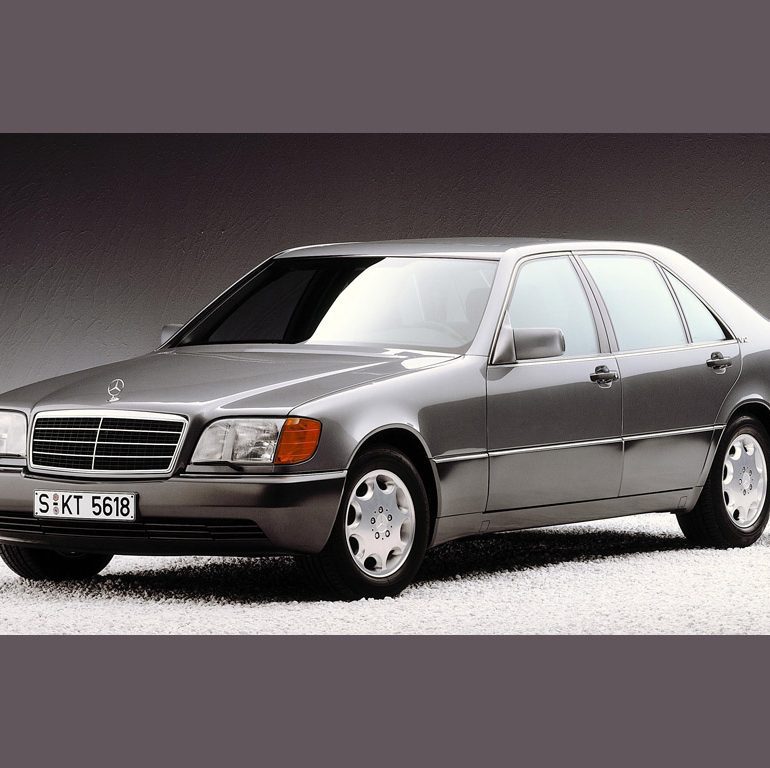1991 Mercedes-Benz 600 SEL
Auto, Motor und Sport, Germany, volume 7/1991, on the Mercedes-Benz 600 SEL: ”With dimensions such as these, there is little to be said about the inte-rior: The sense of space is almost wasteful, even more so in the rear than in the front, since the opulent height in the rear is particularly apt for giving the impression of riding in a mobile living room. ⦠It would not be wrong here to describe this as the worldâs finest car â any less would be to do Mercedes an injustice.”
The 6.0-liter V12 M 120 engine was an entirely new design, not just the first series-produced twelve-cylinder Mercedes-Benz passenger car, but also the most powerful Mercedes-Benz car engine of its day with a rated power output of 300 kW (408 hp). With rated torque of 580 Newton meters, it reached the 500-newtonmeter mark at 1600/min. As with the six-cylinder and the two V8 engines, the twelve-cylinder was also equipped with four-valve technology, variable intake camshaft and an electronic injection system with hot-wire air mass sensor. With all engines a high priority was placed on minimizing exhaust emissions and reducing fuel consumption. The new fully elec-tronic ignition system calculated the optimum ignition point from 300 ignition maps, tuned for each cylinder individually and to the knock limit in each case. The M 120 was the only twelve-cylinder engine worldwide to feature this cylinder-selective anti-knock control. This alone made possible the high compression ratio of 10:1, necessary for optimum use of fuel.
Engine and drive management was also completely new. Here, all con-trol modules communicated with one another via a common data channel, which meant that the control units were jointly active. This served for rapidly warming up the catalytic converters on cold-starting the engine, for example, as well as for acceleration skid control (ASR) and for the new engine friction torque control, which maintained han-dling stability during power-off situations on slippery road surfaces.
The V12 offered the worldâs largest catalytic converter unit for pas-senger cars. With a seven-liter volume in order to avoid any excess fuel consumption on account of the catalytic converter, it ensured a high degree of long-term stability. Thanks to an innovative concept involv-ing a double-walled and triple-insulated exhaust manifold, as well as double-walled pipes, the ceramic catalytic converters â embedded in insulating expandable matting â reached the optimum operating tem-perature in a very short time.
In Detail
| submitted by | Richard Owen |
| engine | V12 |
| position | Front Longitudinal |
| aspiration | Natural |
| valvetrain | DOHC 4 Valves / Cyl |
| fuel feed | Fuel Injection |
| displacement | 5987 cc / 365.3 in³ |
| bore | 89 mm / 3.5 in |
| stroke | 80.2 mm / 3.16 in |
| compression | 10.0:1 |
| power | 304.3 kw / 408 bhp @ 5200 rpm |
| specific output | 68.15 bhp per litre |
| bhp/weight | 185.29 bhp per tonne |
| torque | 580 nm / 427.8 ft lbs @ 3800 rpm |
| body / frame | Unit Steel |
| driven wheels | Front Engine / RWD |
| front tires | 235/60ZR-16 |
| rear tires | 235/60ZR-16 |
| front brakes | Vented Discs w/Vacuum Assist & ABS |
| f brake size | x 320 mm / x 12.6 in |
| rear brakes | Vented Discs w/Vacuum Assist & ABS |
| r brake size | x 300 mm / x 11.8 in |
| front wheels | F 40.6 x 19.0 cm / 16.0 x 7.5 in |
| rear wheels | R 40.6 x 19.0 cm / 16.0 x 7.5 in |
| steering | Recirculatin Ball w/Power Assist |
| f suspension | Air Suspension |
| r suspension | Air Suspension |
| curb weight | 2230 kg / 4916 lbs |
| wheelbase | 3140 mm / 123.6 in |
| front track | 1603 mm / 63.1 in |
| rear track | 1575 mm / 62.0 in |
| length | 5213 mm / 205.2 in |
| width | 1887 mm / 74.3 in |
| height | 1495 mm / 58.9 in |
| gear ratios | :1 |
| top speed | ~255.9 kph / 159 mph |
| 0 – 60 mph | ~6.5 seconds |
| 0 – 100 mph | ~15.0 seconds |






